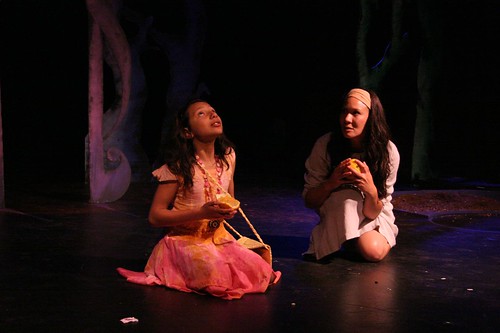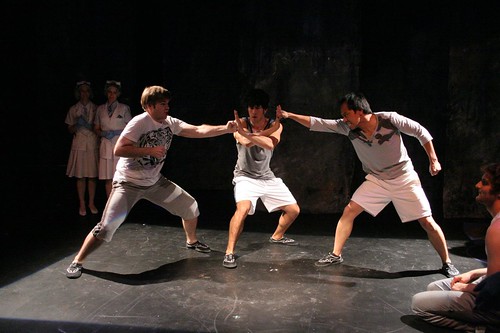
Soraya Gillis (left) is Delphie and Charisse Loriaux is Aya in the Sleepwalkers Theatre production of The Nature Line, the third part of a trilogy by JC Lee. Below: Lissa Keigwin as Dora and Janna Kefalas as Narcy (at left) watch their stud farm perform a talent show. The studs are, from left, Jeff Moran as Go-Go, Roy Landaverde as Pencil, Jomar Tagatac as Benji and Joshua Schell as Jason. Photos by Clay Robeson
If only the actual apocalypse could be so enjoyable.
Hand it to playwright JC Lee for making the end of the world – and after – so lyrical, so funny and so, well, human. That’s one of the things I loved about Into the Clear Blue Sky, Part Two of the This World and After trilogy, which kicked off almost exactly a year ago with This World Is Good. There may be monstrous things happening in the world, things that would require millions of dollars worth of CGI to represent on a screen, but Lee’s focus is essentially human and relatable.
And that’s only appropriate when the topic at hand is the very survival of the human race. In each of his three plays, Lee creates a stage full of seekers, and for his final chapter, they are seeking the future, which is in clear jeopardy.
After the worldwide havoc of the last play, when beasts roamed the planet and peaches became extinct (among other horrors), and attempts to find salvation in an outpost on the moon have apparently failed, there’s not a lot of hope in the future of mankind. Or what’s left of it.
In The Nature Line, Part Three of the trilogy, neither sex nor any human contact of any kind is allowed anymore. Women’s wombs have become unable to handle the stress of pregnancy, so that duty now belongs to scientists who help the process along. “Aren’t you relieved to see a corporate model can survive the apocalypse?” asks a crisply dressed fertility nurse.
Lee doesn’t spend a lot of time in this two-hour, two-act play explaining exactly what is going on, which is probably one of the reasons he’s able to make science fiction work on stage (a tremendously difficult thing to do). He trusts that we’ll fill in blanks and, even better, use our imaginations (to hell with CGI!).
The nature line of the title has much to do with childbirth and natural instincts, so it’s no surprise that the play is so focused on women and mothers. We meet our heroine, Aya (Charisse Loriaux), as she’s conjuring memories of a grandmother she never knew and burying yet another body of yet another dead baby.
This is a grim world, but Aya is not quite giving up on her maternal impulse. Her body may be betraying her, but she is going to submit to the ministrations of the medical professionals one more time because she knows she needs to be a mother.
The quartet of men in the play (Joshua Schell, Jomar Tagatac, Jeff Moran and Roy Landaverde) are fine specimens all. And they really are specimens. They’re kept under quarantine and forced, like prize stallions, to “fertilize” on command, which is to say, make constant sperm donations.
Lee first uses his men as comic relief as we see them performing a testosterone-raising talent show involving all kinds of hip-hoppy-happy dance moves that seem to have survived the end of the world just fine. But as the play progresses, the men become more interesting, even if they are revealed to be grown-up comic book geeks. We even get a sweet, if too-brief love story for a couple of the guys.
But this is Aya’s quest, and as she seeks answers, she finds herself leaving the remnants of civilization and heading into nature – a scary prospect when we’re given to believe that nature could be as damaged and/or as damaging as anything else on the uncertain planet.
All roads, as they say, lead to the sea, and that’s where Aya ends up, although her journey takes her, rather enigmatically, into a reverie (or is it real?) with a Spanish-speaking grandmother (Carla Pantoja) and a little girl who could be one of Aya’s lost children or a young version of Aya herself (played beautifully by fifth-grader Soraya Gillis).
All of these disparate parts – the lyricism, the science fiction, the comedy, the human drama, the romance – hold together because Lee is an audacious, ambitious and uncommonly talented writer.
It also works because, like the previous chapters of the trilogy, it’s produced by Sleepwalkers Theatre, a company that likely has more courage than cash but has the chutzpah to take on a world-premiere apocalypse trilogy and let the plays speak for themselves.
Mina Morita, the director of The Nature Line, emphasizes the human scale here, which is exactly what the play demands. Relationships are key – like between Aya and her closest friend, Arty (Ariane Owens) or between head nurse Narcy (Janna Kefalas) and her assistant, Dora (Lissa Keigwin) or between the sperm studs. The detail to performances is admirable and so important to this production’s success and keeps characters from being just types.
The end of the world, Lee tells us, was quiet, “like a fairy tale” – a far cry from the destruction porn Hollywood churns out with such computer-generated regularity. We don’t know what happened, really, but from the evidence presented by Lee’s trilogy, we know that in art, that most human of expressions, there can be salvation.
FOR MORE INFORMATION
JCLee’s The Nature Line continues through Aug. 27 at the Phoenix Theatre, 414 Mason St., San Francisco. Tickets are $15-$17. Call 415-913-7272 or visit www.sleepwalkerstheatre.com.


Great review thank you!